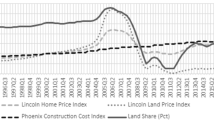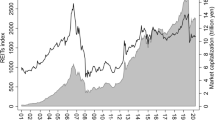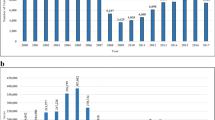Abstract
Prior studies show infrastructural improvements impact property values positively. The effect is often reflected soon after the announcement and continues until the project is complete. These studies, however, are primarily set in developed countries. Emerging markets pose unique risks where uncertainty around implementation and funding could dampen these positive effects significantly. We utilize a quasi-natural experiment around an inner-city road redesign and improvement project in Bangalore, the fastest growing city in India. We exploit the difference-in-difference regression approach to examine the project’s impact on residential and commercial property values around two sets of geographically proximate roads, one of which was chosen for the redesign. Unlike in developed countries, we find that property values are unaffected by the announcement when uncertainty is the highest but start reflecting the positive value of the infrastructure once construction starts and show significant gains upon completion. Our findings carry important policy implications for structuring value capture strategies in emerging markets.


Similar content being viewed by others
Notes
S.U.R.E. is the acronym for "Specifications for Urban Roads Execution.".
Kemp and Mollard (2011) examine similar issues for a more developed market like Australia.
Hack (2002) suggested that the association between public transport investment and land value should be evaluated at multiple points in the project management phase.
Cushman and Wakefield (2014, 2015, and 2016).
See Pandey (2016).
1 USD = 60.936 INR as per average rates in 2013, when Tender S.U.R.E. was announced (https://www.taxesforexpats.com/expat-tax-advice/historical-fx-rates.html).
See Zabel, J. E., & Kiel, K. A. (2000) for an exhaustive overview of variables that may be used for hedonic housing price models.
Alexa is a web traffic analysis company that ranks websites based on popularity and traffic for each sector/keyword. Alexa ranks sites based primarily on tracking a sample set of Internet traffic—users of its toolbar for popular web browsers.
1 USD averaged around INR 55.911 in 2012, 60.936 in 2013, 63.469 in 2014, 66.768 in 2015 and 69.956 in 2016 (https://www.irs.gov/individuals/international-taxpayers/yearly-average-currency-exchange-rates and https://www.taxesforexpats.com/expat-tax-advice/historical-fx-rates.html).
For brevity, we do not present the summary statistics only for the pre-project time period.
For a brief review of the hedonic pricing model and the related literature, see Yen et al., (2018).
We use area and the squared value of the area to account for potential non-linearity in the relationship between size and property values, but our results are qualitatively similar.
We try alternative time windows instead of six months, but our results remain similar.
Exp (coefficient of Log Distance to Metro * 1 km) from Tables 4 and 5 represents the factor by which the value of properties situated away by 1 km deviates from the value of properties closest to the rail metro. For residential rentals, the discount is exp (-0.096*1) = 0.90, or 10% lesser than properties closest to the rail metro.
Using exp (coefficient of Bedrooms * 1 room) from Table 4 minus 1.
Exp (-0.17) = 0.84 (or 16% lower on TS roads than on non-TS roads).
See Table 3 for more details.
RBI’s (Reserve Bank of India, India’s Central Bank) price Index for Bangalore City shows increasing real estate prices, which indicates that landlords may have the bargaining power (short supply, rising prices etc.), and may exploit the intervention through higher rents even at the early stages of the construction. However, we cannot verify this conjecture because of insufficient data. Future research may explore this in more detail.
Exp (Coefficient of TS*Post-phase dummy) from Residential Rent regression in Table 9.
We thank Special issue editor Gangzhi Fan for this suggestion.
References
Ahlfeldt, G. M., & Wendland, N. (2011). Fifty years of urban accessibility: The impact of the urban railway network on the land gradient in Berlin 1890–1936. Regional Science and Urban Economics, 41(2), 77–88.
Acevedo, P., Hobbs, J., & Martinez, S. (2017). The Impact of Upgrading Municipal Infrastructure on Property Prices: Evidence from Brazil. Inter-American Development Bank.
Agostini, C. A., & Palmucci, G. A. (2008). The Anticipated Capitalisation Effect of a New Metro Line on Housing Prices. Fiscal Studies, 29(2), 233–256.
Billings, S. B. (2011). Estimating the value of a new transit option. Regional Science and Urban Economics, 41, 525–536.
Boucq, E., & Papon, F. (2008). Assessment of the real estate benefits due to accessibility gains brought by a transport project: The impacts of a light rail infrastructure improvement in the Haute-de-Seine department. European Transport, 40, 51–68.
Bowes, D. R., & Ihlanfeldt, K. R. (2001). Identifying the impacts of rail transit stations on residential property values. Journal of Urban Economics, 50(1), 1–25.
Cervero, R., & Kang, C. D. (2011). Bus rapid transit impacts on land uses and land values in Seoul Korea. Transport Policy, 18(1), 102–116.
Cohen, J. P., & Brown, M. (2017). Does a new rail rapid transit line announcement affect various commercial property prices differently? Regional Science and Urban Economics, 66, 74–90.
Cushman and Wakefield, 2014, 2015 and 2016. India Assets Survey.
Damm, D., Lerman, S.R., Lerner-Lam, E. and Young, J., (1980). Response of urban real estate values in anticipation of the Washington Metro. Journal of Transport Economics and Policy, pp.315–336.
Debrezion, G., Pels, E., & Rietveld, P. (2007). The Impact of Railway Stations on Residential and Commercial Property Value: A Meta-Analysis. Journal of Real Estate Finance and Economics, 35, 161–180.
Deng, X., Nanda A., and Ong S.E., (2019). Does infrastructure spending lead to price effects in the property market? Evidence from major cities across India. Regional Studies, pp. 1–14.
Deng, T., & Nelson, J. D. (2010). The impact of bus rapid transit on land development: A case study of Beijing, China. World Academy of Science, Engineering and Technology, 66, 1196–1206.
DHNS, (2017). Two TenderSURE roads may not be completed on time. Deccan Herald. https://www.deccanherald.com/content/591051/two-tendersure-roads-may-not.html.
Dubé, J., Legros, D., & Devaux, N. (2018). From bus to tramway: Is there an economic impact of substituting a rapid mass transit system? An empirical investigation accounting for anticipation effect. Transportation Research Part A, 110, 73–87.
Duncan, M. (2011). The impact of transit-oriented development on housing prices in San Diego CA. Urban Studies, 48(1), 101–127.
Efthymiou, D., & Antoniou, C. (2013). How do transport infrastructure and policies affect house prices and rents? Evidence from Athens, Greece. Transportation Research Part A, 52, 1–22.
Fershau, J. E., (2003). Stuck in Gridlock: Agenda-setting and Agenda Management: A Case Study of Translink – the Greater Vancouver Transportation Authority. Doctoral Dissertation, Simon Fraser University.
Golub, A., Guhathakurta, S., & Sollapuram, B. (2012). Spatial and Temporal Capitalization Effects of Light Rail in Phoenix: From Conception, Planning, and Construction to Operation. Journal of Planning Education and Research, 32(4), 415–429.
Government of India, Census of India, (2011). http://www.censusindia.gov.in.
Henneberry, J. (1998). Transport investment and house prices. Journal of Property Valuation and Investment, 16(2), 144–158.
Hack, J. (2002). The Role of Transit Investment in Urban Regeneration and Spatial Development: A Review of Research and Current Practice, in RICS (Ed.), Public Transport and Land Value, RISC and ODPM.
Hans, P. P., (2013). Going to Office. Business Today. https://www.businesstoday.in/moneytoday/cover-story/invest-in-office-space-to-diversify-real-estate-portfolio/story/198000.html.
Hess, D. B., & Almeida, T. M. (2007). Impact of proximity to light rail rapid transit on station-area property values in Buffalo New York. Urban Studies, 44(5–6), 1041–1068.
Jud, G. D., & Winkler, D. T. (2006). The announcement effect of an airport expansion on housing prices. The Journal of Real Estate Finance and Economics, 33(2), 91–103.
Kemp, A. and Mollard, V., (2011). Using value capture mechanisms to finance local road infrastructure. In Australasian Transport Research Forum (ATRF), 34th, 2011, Adelaide, South Australia, Australia, Vol. 34, No. 0239.
Kim, J., Schmöcker, J.-D., Bergstad, C. J., Fujii, S., & Gärling, T. (2014). The influence of personality on acceptability of sustainable transport policies. Transportation, 41, 855–872.
Knaap, G. J., Ding, C., & Hopkins, L. D. (2001). Do plans matter? The effects of light rail plans on land values in station areas. Journal of Planning Education and Research, 21(1), 32–39.
LJ Hooker, (2013). Mid year Report, Residential Real Estate Market Bangalore, http://www.ljhooker.in/2013/Residential_market_midyear, accessed 6th April 2021.
Levkovich, O., Rouwendal, J., & van Marwijk, R. (2016). The effects of highway development on housing prices. Transportation, 43, 379–405.
Li, M. M., & Brown, H. J. (1980). Micro-neighborhood externalities and hedonic housing prices. Land Economics, 56(2), 125–141.
Litman, T. (2003). Measuring transportation: Traffic, mobility and accessibility. ITE Journal, 73(10), 28–32.
McIntosh, J., Trubka, R., & Newman, P. (2014). Can value capture work in a car dependent city? Willingness to pay for transit access in Perth, Western Australia. Transportation Research Part A, 67, 320–339.
McMillen, D. P., & McDonald, J. (2004). Reaction of house prices to a new rapid transit line: Chicago’s Midway line, 1983–1999. Real Estate Economics, 32(3), 463–486.
McDonald, J. F., & Osuji, C. I. (1995). The effect of anticipated transportation improvement on residential land values. Regional Science and Urban Economics, 25, 261–278.
Melser, D. (2020). Estimating the housing capitalization effects of new infrastructure: Should we be using rents instead of prices? Transportation Research Part A, 138, 402–421.
Mohammad, S. I., Graham, D. J., Melo, P. C., & Anderson, R. J. (2013). A meta-analysis of the impact of rail projects on land and property values. Transportation Research Part A, 50, 158–170.
Mohammad, S. I., Graham, D. J., & Melo, P. C. (2017). The effect of the Dubai Metro on the value of residential and commercial properties. Journal of Transport and Land Use, 10(1), 263–290.
Mulley, C. (2014). Accessibility and residential land value uplift: Identifying spatial variations in the accessibility impacts of a bus transitway. Urban Studies, 51, 1707–1724.
Mulley, C., Ma, L., Clifton, G., Yen, B., & Burke, M. (2016). Residential property value impacts of proximity to transport infrastructure: An investigation of bus rapid transit and heavy rail networks in Brisbane, Australia. Journal of Transport Geography, 54, 41–52.
Pandey, G., (2016). Why is Bangalore stuck in traffic jams? BBC News. https://www.bbc.com/news/world-asia-india-38155635.
Pivo, G., & Fisher, J. D. (2011). The walkability premium in commercial real estate investments. Real Estate Economics, 39(2), 185–219.
Ray, A., (2017). TenderSURE project: BBMP pushes Church St revamp deadline to Sept. Times of India. https://timesofindia.indiatimes.com/city/Bangalore/tendersure-project-bbmp-pushes-church-st-revamp-deadline-to-sept/articleshow/59853077.cms.
Rauterkus, S. Y., & Miller, N. (2011). Residential land values and walkability. Journal of Sustainable Real Estate, 3(1), 23–43.
Sharma, D., (2017). Think demonetisation hit real estate sector? RBI data tells a different story. The Economic Times. https://economictimes.indiatimes.com/wealth/real-estate/think-demonetisation-hit-real-estate-sector-rbi-data-tells-a-different-story/articleshow/58276701.cms?from=mdr.
Targa, F. (2003). Examining Accessibility and Proximity-Related Effects of Bogotá’s Bus Rapid System Using Spatial Hedonic Price Models. University of North Carolina at Chapel Hill.
Tsai, C.-H., Burke, M., Mulley, C., & Yen, B. (2017). Exploring property value effects of ferry terminals: Evidence from Brisbane, Australia. The Journal of Transport and Land Use, 10(1), 119–137.
Vadali, S. (2014). Using the Economic Value Created by Transportation to Fund Transportation (NCHRP Synthesis 459). Transportation Research Board.
Voith, R. (1993). Changing capitalization of CBD-oriented transportation systems: Evidence from Philadelphia, 1970–1988. Journal of Urban Economics, 33(3), 361–376.
Yen, B. T. H., Mulley, C., Shearer, H., & Burke, M. (2018). Announcement, construction or delivery: When does value uplift occur for residential properties? Evidence from the Gold Coast Light Rail system in Australia. Land Use Policy, 73, 413–422.
Zabel, J. E., & Kiel, K. A. (2000). Estimating the Demand for Air Quality in Four U.S. Cities. Land Economics, 76(2), 174–194.
Zhang, M., & Yen, B. T. H. (2020). The impact of Bus Rapid Transit (BRT) on land and property values: A meta-analysis. Land Use Policy, 96, 104684.
Acknowledgements
We thank Gangzhi Fan (the editor), Karthik Nagendra, seminar participants at the 2019 Asian Real Estate Symposium, an anonymous referee for their comments and suggestions, and Ekta Jalan for her excellent research assistance. We acknowledge Times Internet Limited and Info Edge (India) Limited for help regarding the listing data used in the paper. All errors remain our own.
Author information
Authors and Affiliations
Corresponding author
Additional information
Publisher's Note
Springer Nature remains neutral with regard to jurisdictional claims in published maps and institutional affiliations.
Rights and permissions
Springer Nature or its licensor (e.g. a society or other partner) holds exclusive rights to this article under a publishing agreement with the author(s) or other rightsholder(s); author self-archiving of the accepted manuscript version of this article is solely governed by the terms of such publishing agreement and applicable law.
About this article
Cite this article
Ghosh, C., Panchapagesan, V. & Venkataraman, M. On the Impact of Infrastructure Improvement on Real Estate Property Values: Evidence from a Quasi-natural Experiment in an Emerging Market. J Real Estate Finan Econ 68, 103–137 (2024). https://doi.org/10.1007/s11146-022-09938-5
Accepted:
Published:
Issue Date:
DOI: https://doi.org/10.1007/s11146-022-09938-5




